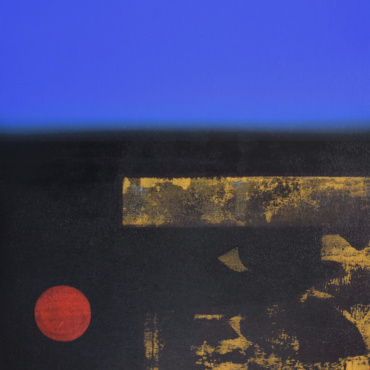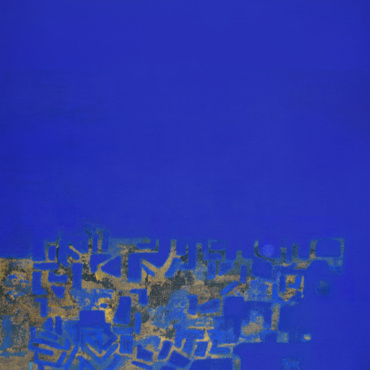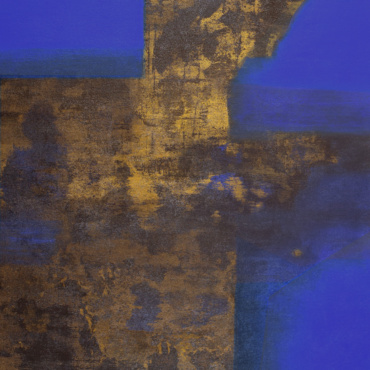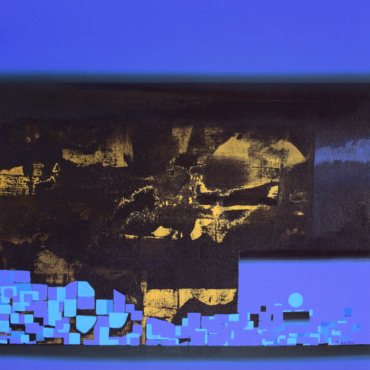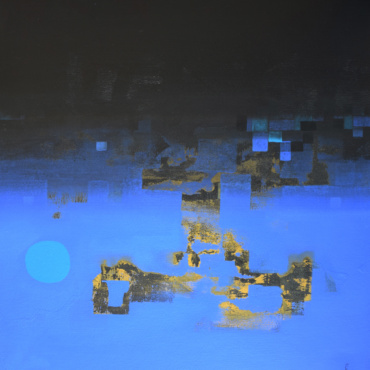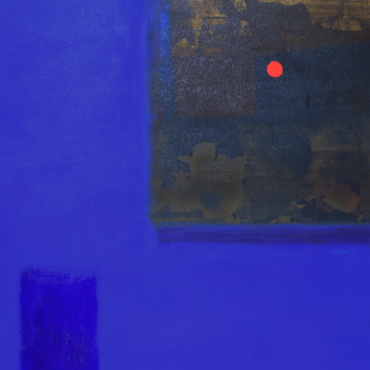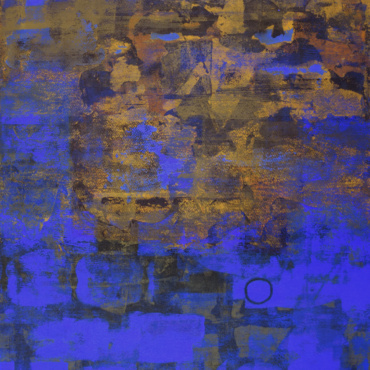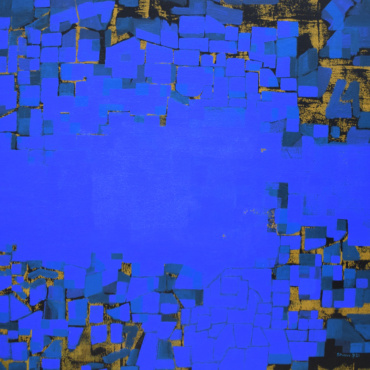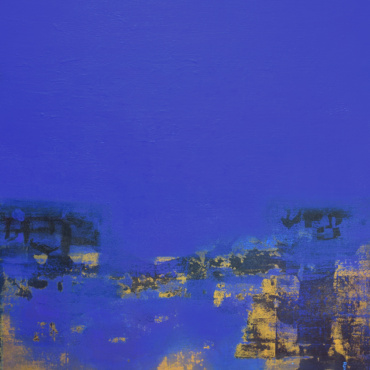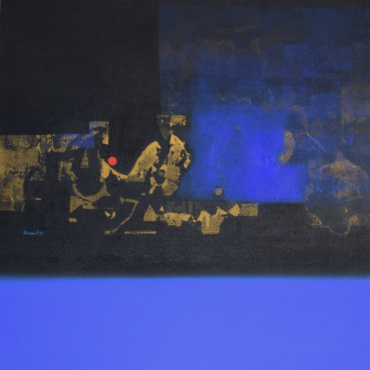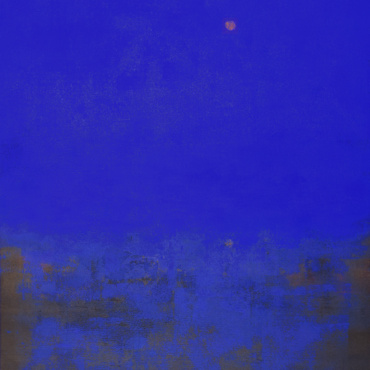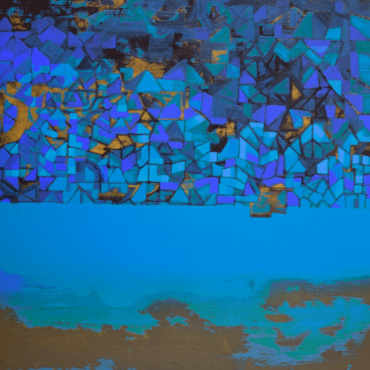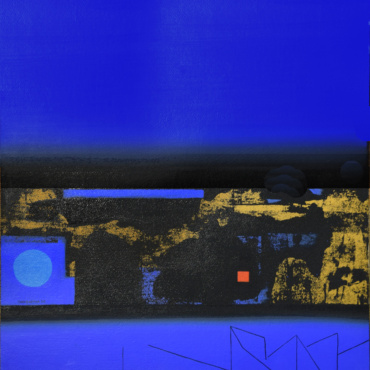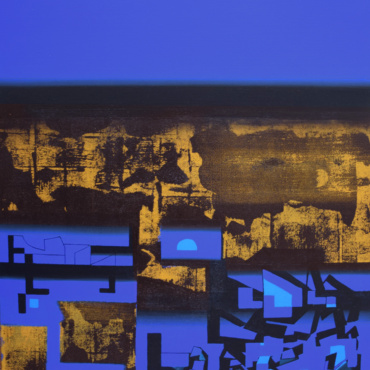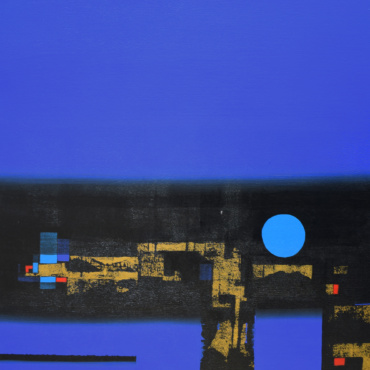Blowing in the blues.
In the month of February 2023, a solo exhibition of Partha Shaw was organized by Debovasha. The event took place in post corona period. And the paintings were done during the restrain of the pandemic. He has his studio in the quiet nook of a multistoried apartment. From morning to evening, he used to spend his entire day before returning to his own place. In those days, his mother who was quite close to his heart was still alive. One may notice his equal amount of dedication to nothing but his work. He prefers solitude and to keep to his own self without much verbal communication. In fact, formal communication does not brother him much. He equally hesitates while talking about himself or his creation. One of his interviews was taken on the occasion of his exhibition at Debovasha. Here we present that very interview. His exhibition was titled as ‘Blowing in the Blues.’ All his paintings exihibited on the website of Debovasha are contemporary of this series and done in blue.
I feel abstraction within me
Partha Shaw (7th October, 1971). Bachelor of Fine Arts, Kala Bhavana (Painting). Master of Visual Arts, Rabindra Bharati. Solo exhibition: Chitrakoot Art Gallery, Kolkata (1995). Gallery 88, Kolkata (2010). Selected Group Exhibition: Sanskrit Art Gallery. Gallery Ganesh. Birla Academy of Fine Arts.
Interviewed by Saurav Dey & Debojyoti Mukhopadhyay. The original interview is taken in Bengali. Translated by Sanjam Pal.
On noticing the brilliant use of blue colour in your works, we have named the Exhibition ‘Blowing in the Blues’. Actually, this name has taken the cue from Bob Dylan’s famous song ‘Blowing in the Wind’ in 1962. But during painting you named this series ‘Spirit of the Nature’ What do you think are the reasons or inspirations for putting such a name?
I share my sorrows with nature. Nature lends me life. We know most of these paintings are done during Corona period. We want to know about the other paintings before and after this period. The reason is our startled attitude on seeing your works which is to be exhibited from 25 February at Debovasha. How different are these paintings from the earlier or later works in the context of your natural and gradual evolution?
The earlier works were done in black and white. I couldn’t tolerate any colour during that period. It happened. Almost eight years I didn’t use any colour barring black and white. But none of us was ready when Corona attacked us. Our days were certainly not happy during Corona period. The 360 o vision during those times is always filled with uncertainty. I tried to paint my works in such a way that the sorrows are transformed into smiles. As in the case of everyone, the sorrows engulfed me. You can say, to cross the sadness my works have unknowingly been changed. After these paintings, as natural, my works have turned to a new domain. Now the call is for soil, leaving aside the abundance of blue. The canvas is all along sprayed with soil and soil.
Why and how did this extension of blue colour in ‘Blowing in the Blues’ originate in your consciousness?
What is the colour of the line wherein the sky and the water mix into one? Water does have no colour. Sky is fully blue. Our state is riverine. Blue colour is favourite to me. I much like to paint nature in blue. Not that the conscious effort was put by me for this type of colouration, rather this colour on its own has spread within me. The Blue colour as we have noticed in the whole series, is not of a single type. Cerulean Blue, Ultramarine and Cobalt Blue– combine in a coherent way. How did you feel the utility or inspiration to use those three variations of Blue? It depends on the painting itself how the variations of Blue can be used. Many a times, the colour tells the artist that it fits here. Colour itself becomes the selector. Primarily, besides three types of blue– red, yellow, black, light brown also show their presence in the context of blue. How all these colours along with blue demand their existence together to you? I view the colours of nature in my own way, and those colours are thrust upon my paintings. Regarding the presence of colour take one easy example– in nature where can we see yellow? Field of ripe paddy is always yellow, you know. Our country is agricultural. And on the other hand I am from Birbhum. Its soil is red. May be due to this the red colour has entered into my paintings.
How do you visualize Nature? We have noticed your nature is not exclusive of urban civilization, rather inclusive. The general perception is actually the contrast between nature and urbanity, but how could you arrange for their coexistence in your paintings?
Nature is absolutely beautiful. No one can create anything by destroying nature. But we are destroying nature. The nature has much to say. It’s having its own joys and sorrows. In my works I tried to paint the sorrows of nature. When viewing your works in the Exhibition, we exclaimed: How Beautiful! Beautiful and mysterious. This beauty and mystery are not the artificial ones in your painting. There is no doubt about the spontaneity of these works. Now, how could you visualize this beautiful and mysterious nature?
I always want to see nature's beauty. I want to bring its beauty in my works to the fullest extent. And this beauty of nature is mysterious also.
Your works are devoid of Figure Drawings, Portraits. How do you identify your paintings– abstract?
I feel abstraction within me. In the school days drawings and sketches were done. From the early years I passed my days at Santiniketan. I learnt my studies in its Ashrama. I started my education in the middle of nature. I never think anything without nature. This obsession is my inspiration. Abstraction– it encompasses my subconscious mind. As we studied in Santiniketan, we learnt respect, honour in the context of its Brahma atmosphere, but no solid thought cropped up regarding Figure Drawings. This being the reason after certain time my paintings are soaked in abstraction.
Recently, you have been using acrylic with an ease. Why are you having such a deep bond with acrylic?
Acrylic is such a medium that pigmentation and wash whatever you want you can do. This easy flexibility has created a bond between acrylic and me.
In this series you have used thick board for painting. Why?
In our younger days we learnt Tempera on thick paper. Nepali paper was pasted on that. That has become the habit. Due to this, I am habituated to work on thick board.
Why do you believe in series painting?
When I draw in a series, I can understand my own movement from one point to other, as if in a story. After many days if I see those together, I can understand my own track. I could feel how I was during those days of painting. The contribution of artist K. G. Subramanyan is noteworthy in this respect. He was my teacher. Let us refer to his murals. He taught us how to draw the works in a series. He guided us to see the Oriental Scroll Paintings. In a Scroll, narration after narration are ultimately added and make stories. I can see my works in the series and I can view my own stories within.
Colour layered on colour and in the middle some geometrical forms are there. And some light black lines which create authority. In total, the creation of nature– we want to know what time it is– dawn or dusk or any other time?
I wake up early. Whenever I see nature, I can visualize the beautiful silhouette which I bring in my paintings. I always like to work on small objects of nature.


